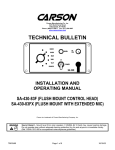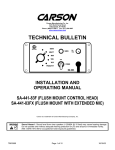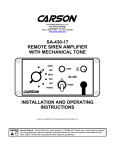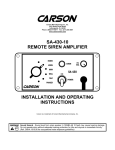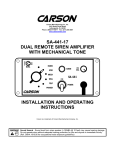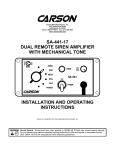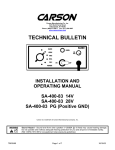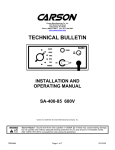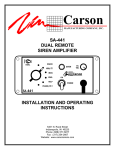Download Carson SA-430-17 Specifications
Transcript
Carson MANUFACTURING COMPANY, INC. CARSON MANUFACTURING CO., INC. 5451 NORTH RURAL STREET INDIANAPOLIS, IN 46220 (888) 577 6877 www.carsonsirens.com TECHNICAL BULLETIN RADIO SIREN HORN PA VOL MAN WAIL ON YELP PHASER POWER SA 430 INSTALLATION AND OPERATING MANUAL SA-430-73F (FLUSH MOUNT CONTROL HEAD) SA-430-73FX (FLUSH MOUNT WITH EXTENDED MIC) SA-430-73V (FLUSH MOUNT WITH VERTICAL LABEL) Sound Hazard - Sound level from siren speaker (>120dBA @ 10 feet) may cause hearing damage. Do not operate siren without adequate hearing protection for you and anyone in immediate vicinity. (Ref. OSHA 1910.95 for occupational noise exposure guidelines) TB0333B Page 1 of 10 10/18/03 SA-430-73 INPUT POWER: SIREN MODE OUTPUT POWER: AUDIO MODE OUTPUT POWER: SIREN FREQUENCY: CYCLE RATES: AUDIO RESPONSE: SPECIFICATIONS 11-16 Volts DC, 8 Amps DC per 100W Speaker Power off current to amplifier is 25mA Max. 15 VDC input, 100W speaker(s) One speaker - 105 Watts RMS Two speakers - 180 Watts RMS Rating not available for 58W or 80W speakers 14 VDC input, 100W speaker(s) One speaker - 40 Watts RMS Two speakers - 80 Watts RMS Rating not available for 58W or 80W speakers 600Hz - 1350Hz Nominal WAIL - 14 cycles/min YELP - 190 cycles/min PHASER - 15 cycle/sec 200Hz - 10KHz +/-3db Harmonic Distortion Less than 3% @ 1KHz RADIO INPUT SENSITIVITY: 0.75VAC Input Min. for 40 Watts RMS Output (1 spkr) OPERATING TEMPERATURE: -15° F to +140° F SIZE: Amplifier Control Head 8-7/8" Wide X 1-13/16" High X 5-1/2" Deep 6-1/4" Wide X 2-7/8" High X 1" Deep WEIGHT: Amplifier Control Head 2.5 pounds 1 pound NIGHT VISIBILITY: Control Head panel is backlit with independent lead tied to vehicle dash lights. AMPLIFIER PROTECTION: High Voltage – Siren output stops with input voltage above highest rating Stops high output power from blowing speaker Reverse Polarity - Fuse blows when power is wired backwards Shorted Output – Fuse blows if speaker shorts (a common problem) CONTROL HEAD PROTECTION: No fuse but has reverse polarity protection. NOTICE Due to continuous product improvements, we must reserve the right to change any specifications and information, contained in this manual at any time without notice. Carson Manufacturing Co., Inc. makes no warranty of any kind with regard to this manual, including, but not limited to, the implied warranties of merchantability and fitness for a particular purpose. Carson Manufacturing Co., Inc. shall not be liable for errors contained herein or for incidental or consequential damages in connection with the furnishing, performance, or use of this manual. TB0333B Page 2 of 10 10/18/03 INSTALLATION Proper installation of the unit is essential for years of safe, reliable operation. Please read all instruction before installing the unit. Failure to follow these instructions can cause serious damage to the unit or vehicle and may void warranties. SAFETY PRECAUTIONS For the safety of the installer, vehicle operator, passengers and the community please observe the following safety precautions. Failure to follow all safety precautions and instructions may result in property damage, injury or death. Qualifications - The installer must have a firm knowledge of basic electricity, vehicle electrical systems and emergency equipment. Sound Hazard - Sound level from siren speaker (>120dBA @ 10 feet) may cause hearing damage. Do not operate siren without adequate hearing protection for you and anyone in immediate vicinity. (Ref. OSHA 1910.95 for occupational noise exposure guidelines) Mounting - Mount the control head for easy access by the vehicle operator. DO NOT mount in air bag deployment area. Assure clearances before drilling in vehicle. Wiring - Use wiring capable of handling the current required. Make sure all connections are tight. Route wiring to prevent wear, overheating and interference with air bag deployment. Install and check all wiring before connection to vehicle battery. Testing - Test all siren functions after installation to assure proper operation. Test vehicle operation to assure no damage to vehicle. Keep These Instructions - Keep these instructions in the vehicle or other safe place for future reference. Advise the vehicle operator of the location. AMPLIFIER MOUNTING Choose a mounting location in an area such as the driver compartment firewall, under a seat, etc. Mounting the amplifier in the engine compartment or in an area directly exposed to weather is not recommended. Assure adequate ventilation to prevent overheating. Consider wire routing and access to connector. Install amplifier to vehicle using 1/4" hardware (not supplied). May need to set RADIO VOLUME ADJUST on side of amplifier before final mounting and installation. May also need to set POWER OUTPUT ADJUSTMENT on inside of amplifier. CONTROL HEAD MOUNTING Select a mounting location in an area such as the dash or overhead console. Choose a mounting location convenient to the operator and away from any air bag deployment areas. Consider wire routing and access to connections, as well as microphone bracket placement. A microphone clip along with mounting screws (CP3633) holds the microphone in place. FLUSH MOUNT The flush mount control head requires a hole in the dash. Use the mounting template on the last page. Note that the template may not print actual size and may need sizing on a copier. Use #6 screws to fasten to dash. FLUSH MOUNT WITH EXTENDED MICROPHONE The flush mount control head with extended microphone is mounted the same as the flush mount except that the microphone cable extension will also go behind the dash. Allow room for this cable as well. Control Head – Rear View Microphone Extension Cable TB0333B Page 3 of 10 10/18/03 CONTROL HEAD ELECTRICAL CONNECTIONS All control head leads may be extended with #22 AWG or larger lead wire. Negative Connection (Black) - Connect to same ground or negative supply as amplifier. Positive Connection (Red) - Connect to positive DC supply. It is recommended that the lead be connected to the accessory output of the fuse block. This provides additional protection of a fused input to the control head. Lights (Yellow) - This lead may be connected to the dash lights or to the red power lead. Connecting to the dash lights will turn on the panel lights whenever the dash lights are on. When connected to the red lead, make sure that the ignition switch controls the power to that connection. This prevents the panel lights from being continuously on. Control (White) - Connect to white lead from amplifier. Route this lead away from radio transmitter antenna lead to prevent RF interference being fed to the siren amplifier. Auxiliary Input (Green) - Used for Siren control. Performs same function as Siren button. Connect to a normally open switch or to horn ring circuit. Circuit may connect to either positive or negative. When connected to horn ring circuit, use a SPDT switch to connect horn ring to either vehicle horn or to manual control circuit. NOTE: Permanent disconnection of the vehicle horn is NOT recommended. NOTE: Be sure to cut lead short if not used to prevent R.F. interference and insulate with electrical tape. Added SPDT Switch HORN RING SWITCH HORN AUX HORN RING CONNECTION TB0333B Page 4 of 10 10/18/03 AMPLIFIER ELECTRICAL CONNECTIONS Disconnect vehicle battery before making the following electrical connections. Electrical connections to the amplifier are made using the wiring harness supplied. If the amplifier needs service the connector can be easily removed without unwiring the harness. The power supply for the amplifier must be capable of delivering peak currents up to 50 amps for adequate short circuit protection and reliable operation. The preferred source is directly at the vehicle battery. A fuse on the unit protects from overload. Wire Size and Termination - The diagram shows the minimum wire size used for each connection. If the wire is longer than 10 ft. use the next larger wire size. Use only high quality crimp connectors for installation on the vehicle. Negative Connection (Black) - Both leads must be used. Connect to negative battery connector or high current buss. Positive Connection (Red) - Both leads must be used. Connect to positive battery connector or high current buss. A power relay may be used. Speaker Connection (Brown) - Both leads must be used. Connect 1 lead to each terminal or lead of the speaker. When used with 2 speakers connect each brown lead to both speaker terminals or leads (parallel circuit). Observe polarity (phasing) when connecting 2 speakers. Control Connection (White) - Connect to white lead from control head. Route this lead away from radio transmitter antenna lead to prevent RF interference being fed to the siren amplifier. Optional Radio Input Connection (Blue) - Connect 1 lead to each terminal of the radio speaker or output connector. The input is isolated and polarity is not important. May need to set RADIO VOLUME ADJUST on side of unit. #14 AWG RED Use both leads Extend with #12 CONTROL HEAD + BAT GRN (AUX) RADIO - SIREN HORN #14 AWG BLK Use both leads Extend with #12 VOL MAN WAIL BLK (-VDC) ON YELP PHASER POWER RED (+VDC) (2) #18 AWG BRN (#16 - 2 SPKR) 2 - SPKR - Connect for same phase (+ to +) RADIO (2) #18 AWG BLU Connect to output jack, terminals or speaker of radio CONTROL WHT CONTROL AMPLIFIER CP2560 CABLE #18 AWG WHT AMPLIFIER WIRING HARNESS CONNECTIONS TB0333B YEL (DASH LIGHTS) 20AMP FUSE AUTOMOTIVE TYPE BLK TO -VDC BLU TO TWO WAY RADIO SPEAKER BRN TO SPKR Page 5 of 10 RED TO +VDC 10/18/03 OPERATION Sound Hazard - Sound level from siren speaker (>120dBA @ 10 feet) may cause hearing damage. Do not operate siren without adequate hearing protection for you and anyone in immediate vicinity. (Ref. OSHA 1910.95 for occupational noise exposure guidelines) RADIO SIREN HORN PA VOL MAN WAIL ON YELP PHASER POWER SA 430 The Toggle Power Switch controls the siren power. The siren may be left on any time the vehicle is in operation. The power should be turned off when vehicle is not being used to conserve battery power. The Rotary Function Switch selects various operating modes. These modes are as follows: RADIO - This mode reproduces, or repeats, the output of a radio. The radio must be connected and RADIO VOLUME ADJUSTed for this mode to function. PA override available in this mode. HORN - Also considered a standby mode. Horn and PA Override available in this mode. MAN - The siren tone is controlled Manually with SIREN button. PA Override available in this mode. WAIL - The siren produces a normal rise-fall tone pattern. This mode should be used on highways or areas with constant traffic flow. Yelp and PA Override available in this mode. YELP - The siren produces a moderate warble tone. This mode should be used in lightly congested areas. Horn and PA Override available in this mode. PHASER - The siren produces a very fast warble tone. This mode should be used at intersections or in highly congested areas. Horn and PA Override available in this mode. OVERRIDE FUNCTIONS PUBLIC ADDRESS (PA) OVERRIDE - Pressing the microphone button in any operating mode allows the operator to use the siren as a public address amplifier. The operating mode resumes when the button is released. (Hold the microphone close to your lips for proper operation and adjust the PA VOLume Control) HORN OVERRIDE - By pressing the SIREN button the siren tone output is replaced by the horn tone. The siren tone resumes when the button is released. (This feature is not available in WAIL mode.) YELP OVERRIDE - Available only in WAIL mode. By momentarily pressing the SIREN button the tone output is switched to the Yelp tone. Pressing the button again switches the tone output back to Wail. TB0333B Page 6 of 10 10/18/03 RADIO VOLUME ADJUST The RADIO VOLUME ADJUST is a one time setting which depends on the radio connected and its normal volume. Access the RADIO VOLUME ADJUST through a hole on the side of the amplifier. Switch siren to RADIO mode and turn on the power. With the volume on the radio itself set to normal level, set the RADIO VOLUME ADJUST to the desired level. POWER OUTPUT ADJUST The POWER OUTPUT ADJUSTMENT is a one time setting which depends on the speaker(s) used. The amplifier cover must be removed to access the adjustment. Remove the 4 screws on the side of the amplifier. For 58W or 80W speaker(s), set the POWER OUTPUT SWITCH to “58/80”. For 100W speaker(s) set the POWER OUTPUT SWITCH to “100”. POWER OUTPUT SWITCH (INSIDE AMPLIFIER ON CHASSIS) RADIO VOLUME ADJUST 58/80 TB0333B Page 7 of 10 100 10/18/03 SERVICE This unit is designed to provide years of reliable service under even the worst conditions. Many times there may appear to be a problem with the unit when the true problem is in the speaker(s) or improper installation. The following chart shows typical symptoms and possible causes. A blown fuse doesn't necessarily mean that the unit is bad. If a speaker or speaker lead is shorted this fuse will blow before the unit is damaged. Disconnect the SPKR leads and replace the fuse. If the siren emits a sound when in the Yelp position it is OK. Check the speaker(s) or leads for possible shorting. PROBLEMS Symptom No Power or siren output Possible Cause Power switch not turned on Bad Speaker Connector or connections loose Fuse blown Loose connection at power source No siren tone – PA works No PA Distorted siren sound High Voltage Protection Mic Button stuck PA volume not set properly Speaker assembly loose Intermittent Aux Input connection Low Vehicle voltage High Voltage Protection Connector loose Loose connection at power source Mic Button activation Circuit breaker in supply connection Siren switch stuck Aux Input improperly connected Intermittent siren tone Horn or manual stuck on No Radio Unit not connected to a radio Radio volume too low Wrong siren tone Ground system noise Check Does backlighting come on? Do you hear a “pop” when turned on? With siren on, yelp selected, listen for tone in amplifier. Is an external fuse or circuit breaker used? Are the power leads connected to a good buss? The input voltage must be less than highest rating. Does Mic Button release properly? Try turning the PA volume control. Is the speaker bell or tip loose? Is the Aux Input used and wired properly? The input voltage must be greater than lowest rating. Is the vehicle voltage regulator working properly? Is the connector tight on the back of the unit? Check for loose leads back to power source. Is something lying on the microphone? Is a circuit breaker used with at least 50A rating? Does the Siren pushbutton switch return fully when released? Is the Aux Input used and wired properly? Is the radio connected properly to the unit? Can you hear the radio in the vehicle? Try adjusting the internal radio volume control. Are control head and amplifier connected to good ground? RETURN If you have any questions concerning this or any other Carson product, please contact our Technical Service Department at (888) 577-6877. Many issues can be handled over the phone. We can also be reached via e-mail at [email protected] If a product must be returned for any reason, please contact our Technical Service Department to obtain a Returned Merchandise Authorization number (RMA#) before you ship the product to Carson. Please write the RMA# clearly on the package near the mailing label. Be sure to provide a return address, contact and phone number, along with a brief description of the problem. TB0333B Page 8 of 10 10/18/03 PARTS 1 7 5 6 2 4 RADIO PA VOL SIREN HORN 8 MAN WAIL 3 9 ON YELP POWER PHASER SA 430 13 11 10 12 Control Head Item 1 2 3 4 5 6 7 8 9 Part # 8025 DRS/CAP CP3040 ES00003-09 CP3046 CP4000 CP3045 CP3880 CP4852 CP4853 CP3149 CP3853 JKL#7001PSBL CP3570 ES00028-10 CP3633 CP3035-1 SR3055 8121D2V40 7101-T-C-Q CP3599 Description Button, red w/ dress nut (C&K #801803000 Cap, #702501201 Nut) (for pushbutton switch) Cable, control head power Cable, microphone extension 8FT (CP3850 is 18FT) (for SA-430-73FX version) Control, PA volume (1K ohm) (for all other PCB's) Control, PA volume no face mount (1K ohm) (for PCB CP3873 Rev. E and higher) Cover, control head back (for PCB CP2602) Cover, control head back push on (for PCB CP3873) Knob, rotary function switch Knob, PA volume control Label, control head front panel (for SA-430-73F and FX version) Label, control head front panel vertical (for SA-430-73V version) Lamp, T-1-3/4 14V Bi-pin (JKL #7001) Microphone (for SA-430-73F and V version) Microphone with locking connector (for SA-430-73FX version) Microphone clip with mounting screws Panel, control head front Rivet, plastic snap for back cover (Richco #SR-3055B) Switch, pushbutton siren (C&K #8121SD2V4GE) Switch, toggle power (C&K #7101TCQ) Switch, rotary function Amplifier Item 10 11 12 13 Part # CP3866 CP2560 CP3606 CP3408 SR3055 CP4119 TB0333B Description Cable, amplifier internal chassis plug wiring harness Cable, amplifier external wiring harness Cover, amplifier (does not include CP3605 chassis) Fuse holder Rivet, plastic snap for PCB mount (Richco #SR-3055B) Transistor, output (2 required) (Industry standard TIP36C, Not Texas Instruments) Page 9 of 10 10/18/03 TB0333B Page 10 of 10 2-7/8” 2-1/2” CAUTION: Please note that top and bottom edges only provide 1/8” overlap. Cut carefully. This inner area to be removed. 5-1/4” 5-7/8” 6-1/4” 1/8” 2-5/8” 1/2” CONTROL HEAD INSTALLATION TEMPLATE 10/18/03










